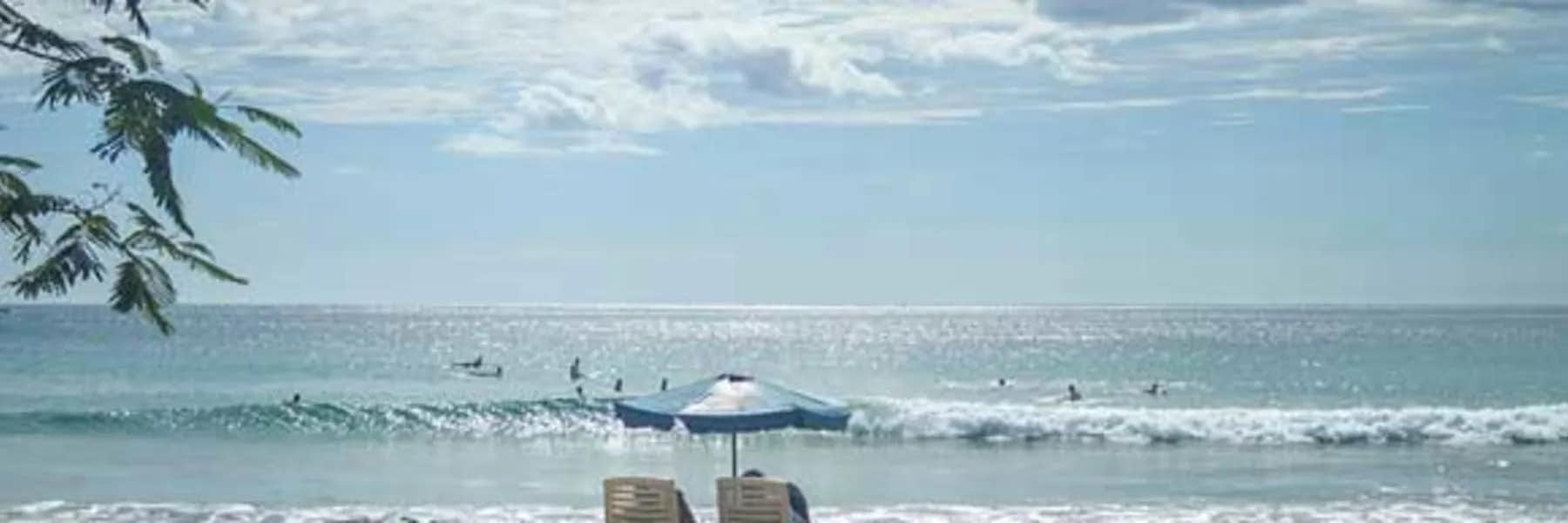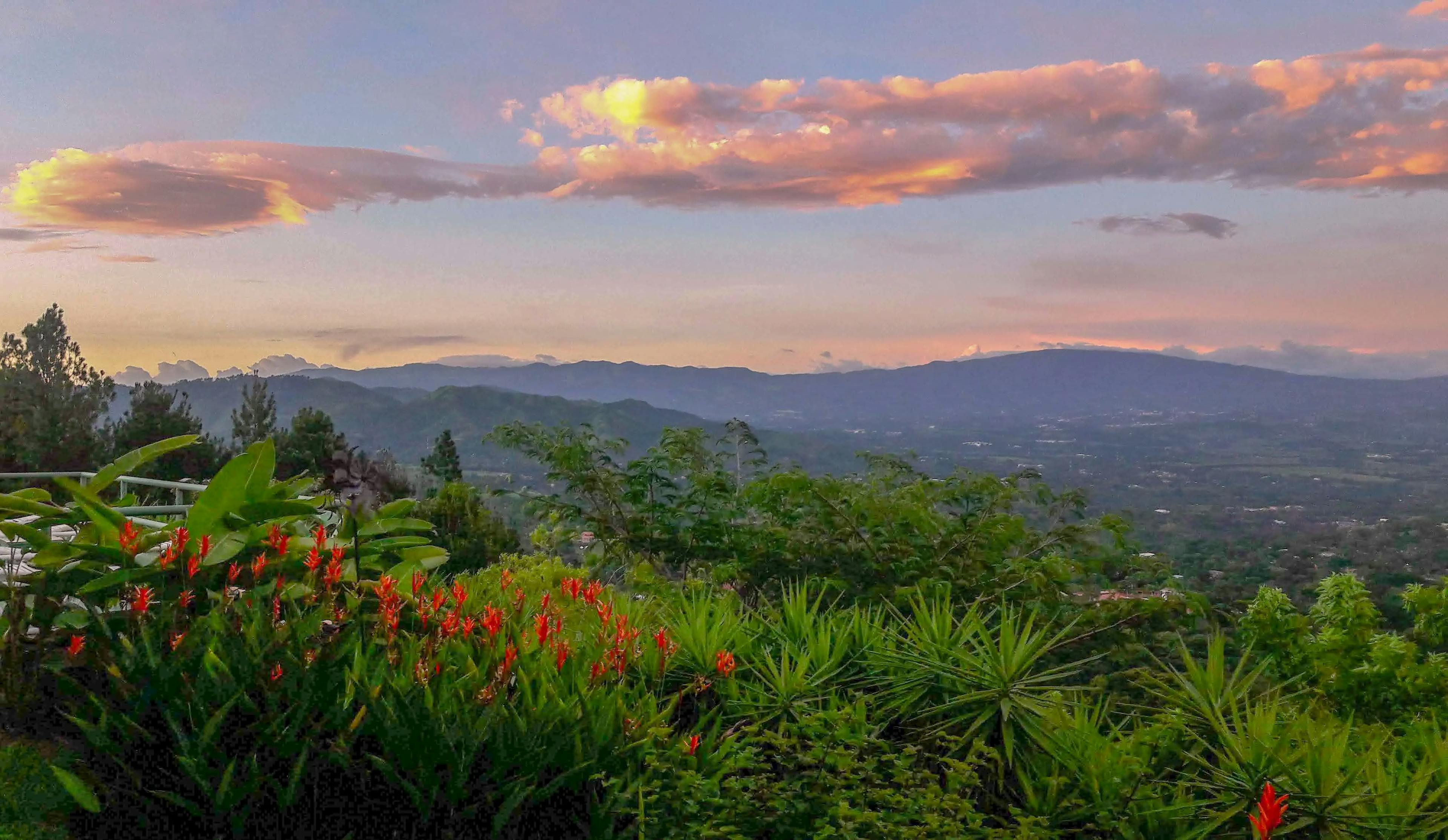“Buenas!” “Hola!” “Pura Vida!” Common greetings among friends and strangers alike.
Despite a surge of growth, Tamarindo still offers that “place where everybody knows your name, ” small-town vibe.
Historically this Pacific coastal town nestled along the Nicoya Peninsula of Costa Rica’s Guanacaste region, just two-and-a-half hours south of the Nicaraguan border, was a quiet fishing town. A few boats in the bay and not much else other than lush flora and native wildlife.
Not until the 1970s did some curious surfers stumble upon this otherwise undiscovered beach town and recognize the incredible surf break that exists just offshore. Shortly after, in 1974, Coopeguanacaste (the electric cooperative servicing the Nicoya Peninsula) brought electricity to Tamarindo--while the arrival of landline phones was still far ahead, not arriving until 1996.
Pun intended, Tamarindo caught its big break when its once-secret surf breaks, scenic beaches, and pura vida lifestyle starred in the 1994 surf movie Endless Summer II. The film has been renowned since its release for attracting a cult-like following of surfing nomads and nature lovers to seek the idyllic spots that had been scouted out by the filmmakers. Sure enough, just a few years following the film’s release, Tamarindo began to evolve into a bustling beach hub.
With just over two miles of golden sand, the beach stretches from one end at the mouth of the Tamarindo estuary to the other, where a point formed from volcanic rock separates Tamarindo from its neighboring Playa Langosta. The palm tree-lined beach is postcard quality, with its pristine blue and turquoise waters. Drawing sunbathers, yogis, beach volleyball, soccer players, and surfers of all skill levels; there is plenty to do for those seeking an active lifestyle.
Beyond the palms, separating the beach from the town, the charming main road is lined by beachfront restaurants, bars, hotels, yoga studios, souvenir stores, surf shops, real estate offices, and a couple of day spas - including a trendy new fish pedicure shop.
Aside from the world-renowned surf and paradise-like atmosphere, Tamarindo proved to be no one-hit-wonder when it garnered international attention once again in 2004 for being located within one of the world’s five “Blue Zones”—areas where people regularly reach the age of 100, and in good health.
Of course, this comes as no surprise. The Nicoyan water boasts the highest calcium content in the country, lowering rates of heart disease and strengthening bones. Also, the diet in the region is based on staples including rice, beans, and maize. Very few processed foods are consumed, fruits high in antioxidants are highly accessible, and people tend to consume fewer calories overall.
With one of the warmest and driest climates in the country, Tamarindo and the surrounding region experiences direct sunlight nearly every single day of the year. Temperatures are consistent year-round, fluctuating normally between 80 F and 95 F. Even during the “rainy” season, lasting approximately from May to October, a day without sunshine is rare.
All that said, it’s easy to understand how this town has become one of Costa Rica’s most popular beach towns; popular among ticos (native Costa Rican), but also a large expat community and tourists from around the world. With a growth in popularity has come a growth in amenities and infrastructure.
Located just over an hour from Daniel Oduber Quirós International Airport in Liberia, LIR accessible via a paved road the whole way, Tamarindo is about as convenient as it gets for a beach town that still allows you to “get away from it all.” And if you need to head to the nation’s capital of San José, you can drive along a paved highway and be there in about five hours. Scheduled daily bus service to and from San José and other larger cities is available and reliable too.
You’ll find three banks in town, including Banco de Costa Rica and Banco Nacional (the country’s two largest chains). There’s a local hardware store for basic needs and a couple of shops offering services like printing, faxing, scanning, and copies.
So the question is, what if there were a place where you could enjoy the tranquility of the beach, yet the excitement of a busy little town? A place where both relaxed retirees or ambitious digital nomads can thrive. A place with just enough modern-day amenities to suit your everyday needs, but not so developed to hinder its slightly bohemian, off the beaten path charm. This place exists, in Tamarindo, and could be the perfect spot for someone ready to reinvent life as they know it with a daily dose of sun, sand, and a tropical ocean breeze.
Get Your Free Costa Rica Report Here
Get Your Free Costa Rica Report Here
Learn more about Costa Rica and other countries in our daily postcard e-letter. Simply enter your email address below and we’ll send you a FREE REPORT - Explore the Old World in Laidback Costa Rica.

By submitting your email address, you will receive a free subscription to IL Postcards and special offers from International Living and our affiliates. You can unsubscribe at any time, and we encourage you to read more about our Privacy Policy.
Retire in Tamarindo
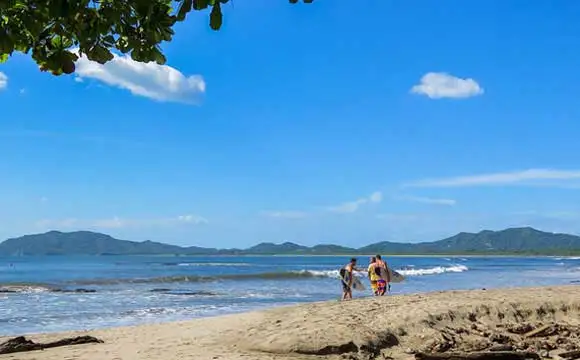
Tamarindo, Costa Rica offers a little something for everyone interested in an affordable, peaceful, and simple beachside retirement.
It’s a town where everyone knows your name, but also offers plenty of places and spaces to enjoy time by yourself. A beach community offering modern amenities and day-to-day necessities, but also a slower pace and a bit of an old fashioned sentiment. A hot and dry climate offering sunshine nearly every day of the year, and welcomed tropical showers to bring out pops of color among the local flora. A haven for outdoor adventure seekers and nature lovers.
In comparison with many of the popular North American coastal retirement destinations, one of the most desirable attributes of Tamarindo is the affordable tropical setting. It is possible for a couple to live in Tamarindo on a monthly budget of $2,000 to $3,000, and unique from many other Central American destinations, Tamarindo also offers luxury living, should that be what you’re looking for. Aside from housing, the two most costly budget items will be electricity and imported goods.
Sometimes the scariest part of retiring abroad is the thought of being far from family and friends, but amidst all the things that make Tamarindo a postcard-perfect destination, what many expats enjoy most is the instant sense of community they experience here. With a mix of locals, retirees, digital nomads, and surfers from around the world, people tend to be friendly and welcoming, and newcomers don’t stay “new” for long. In addition to the ease and accessibility of air travel, this helps calm some of the common nerves before the big move.
There are also several Tamarindo Facebook groups you can join in advance to ask questions and gauge if this could be the right place for you, such as Tamarindo Chit Chat and Tamarindo Garage Sale for starters. There is also a local non-editorial English newspaper in Tamarindo called the Swell Dealer. In it you will find information to make life easier (including a calendar of classes and social events, maps, bus schedules, emergency numbers, restaurant specials, etc.).
For years now, Tamarindo has remained one of the most popular retirement destinations for North Americans not only in Costa Rica, but in all of Central America, and hopefully this overview provides a glimpse into the many reasons why.
Lifestyle in Tamarindo

Modern Nicoyans have strong roots to the indigenous Chorotega, whose traditions have been hailed for enabling people to remain relatively stress free. Alas, the “pura vidalifestyle” people rave about after having been to Tamarindo.
For many, daily sightings of howler monkeys and a variety of lizards never gets old. Between the monkeys and the plethora of tropical birds found here, chances are you’ll be waking to the tune of a different type of alarm clock.
Being able to get pretty much anywhere in town within 10 to 15 minutes on foot is a major draw for the roughly 1,500 year-round residents (a population that swells to 5,000 or so during peak times for tourists and part-time residents). If you need to take a taxi for any reason, it will usually cost between $3 and $5 and public bus fare to get you to surrounding cities are low. For example, to go to Santa Cruz (the local municipality center) would be $1.30, and a bus ride to Liberia will only cost $2.50.
While the nearest hospital is in Liberia, in town you do have access to doctors through local clinics as well as multiple pharmacies. In nearby Huacas, there is a 24/7 clinic, Beachside Clinic, with an x-ray machine and a lab for full blood work testing. There are five accessible grocery stores as well as the weekly feria (farmers’ market) on Saturdays. At the feria you can purchase locally grown produce, and other local products like herbs and spices, cheeses, fresh fish, and eggs for a fraction of the cost you’d normally pay. The Thursday market is more of a social event centered around food, drinks, music and vendors selling jewelry, clothing and other arts and crafts.
Whether you want to learn to surf, log some hiking mileage, catch your own dinner out at sea, lounge seaside in a hammock, or put a dent in your reading list, each day can be as action-packed or relaxed as you choose and is guaranteed to come to a close with an extraordinary Pacific coast sunset.
Beach Living at its Best
By Jason Holland
You couldn’t accuse it of having a secluded, deserted beach. But living in Tamarindo, Costa Rica certainly has its rewards.
Where to Live
You’ll find a variety of options when it comes to housing, from apartments and condos to large ocean-view homes. North American style three-bedroom homes or condos five to ten minutes from the beach around Tamarindo can be had for $275,000; two-bedrooms from around $200,000. But if you want to be in the center of town or in the hills with sweeping ocean views, expect to pay more. Be aware when you are looking at real estate online, many realtors list properties in “Tamarindo” when they are located in the less expensive inland nearby towns of Villareal and Huacas.
A plethora of vacation rentals also means you can easily visit for a month or two to try out living in Tamarindo, Costa Rica before you make a permanent move.
There are several local rental companies and multiple listing on Airbnb and VRBO. You will find the best rental rates during low season after Spring Break/Easter through early June and again in late August through mid-November.
Tamarindo is a very walkable town. So no matter where you live the beach and town will be only, at most, 10 to 15 minutes away.
Medical Care
Since it is a popular vacation spot, the medical care in Tamarindo isn’t what you’d find in other less seasonal communities. There are doctors (associated with pharmacies) and dentists in town, and a few minutes’ drive further inland.
But for treatment for serious conditions, you’ll need to head to Liberia, the capital of the Guanacaste province. There you have a large public hospital (open to legal residents, including expats, only - unless it’s an emergency) and one private hospital downtown, San Rafael Arcángel. If you have ongoing specialized medical needs, you will want to live closer to San Jose, where the bulk of the large medical centers and hospitals are located.
Water Sports Galore
If you’re into water sports, Tamarindo is your place. Surfing, of course, dominates. It’s actually the perfect place for beginners, with tame waves along most of its length. There are also bigger breaks for more experienced wave riders. More than a dozen surf schools are strung along the beach, ready with boards and expert instructors.
Kayaking and stand up paddle boarding are also popular here.
Dining Out
For a town of about 4,000, it’s surprising just how many different types of food you can find.
The many Italian expats here have brought several restaurants dedicated to their home cuisine. La Baula is an open air place specializing in my personal favorite, wood-fire pizza baked in a brick oven.
You can also find gyros and falafel (Middle Eastern food is very rare in Costa Rica) at Falafel Bar. Just $4.50 for a big pita sandwich – and they don’t skimp on the ingredients.
Also try LongBoard BBQ, which has great American-style barbecue with awesome smoky sauce, another rarity in this country. It’s cheap too, a pulled pork sandwich with side is just $5.
If you enjoy Asian food, trendy and meticulously decorated Wok and Roll features some of the most popular dishes from Korean bibimbap to Mongolian BBQ and Vietnamese pho to Thai curries. And of course, Japanese sushi.
In addition to these choices, you’ll find ceviche, American sports bar fare, gourmet sandwiches, Mediterranean, Asian fusion… the list goes on.
Community
Of course, there are several restaurants and bars right on the beach. It’s the perfect place to enjoy sunset.
That’s where the “not a secluded beach” part comes in. You’ll soon learn living in Tamarindo, Costa Rica that the beach is the community gathering place. And sunset is peak time – a celebration of sorts.
People walk their dogs, surfers get one last session in, kids are playing, impromptu soccer games are held, cocktails enjoyed. It’s the place to meet with friends or make new ones.
And that sense of community is one of the things that makes Tamarindo special.
Getting There
Getting to Tamarindo is easy. The Daniel Oduber International Airport in Liberia offers many flights from North America, Panama, and Europe. The modern, new airport was opened in 2012 and it has already been expanded in 2018 to meet the demands of increased flights. It’s just an hour taxi ($50-$80) or bus ride ($3) to Tamarindo, with frequent service offered. You can also get door-to-door shared shuttle transport for $20 through the Tamarindo Shuttle.
From Juan Santamaria Airport in San Jose, the trip by bus is approximately four to five hours and costs less than $10. Transport by shared van or shuttle will run you about $37 to 60 per person (Interbus or Gray Line) and private car $180 to $240. You might consider renting a car for the trip since all the major rental car companies are in Tamarindo for drop-off.
Tamarindo is also home to a national airport (TNO) with multiple daily flights from San Jose and Liberia on the local airlines Sansa, Aerobell, and Skyway.
Get Your Free Costa Rica Report Here
Get Your Free Costa Rica Report Here
Learn more about Costa Rica and other countries in our daily postcard e-letter. Simply enter your email address below and we’ll send you a FREE REPORT - Explore the Old World in Laidback Costa Rica.

By submitting your email address, you will receive a free subscription to IL Postcards and special offers from International Living and our affiliates. You can unsubscribe at any time, and we encourage you to read more about our Privacy Policy.
Cost of Living in Tamarindo
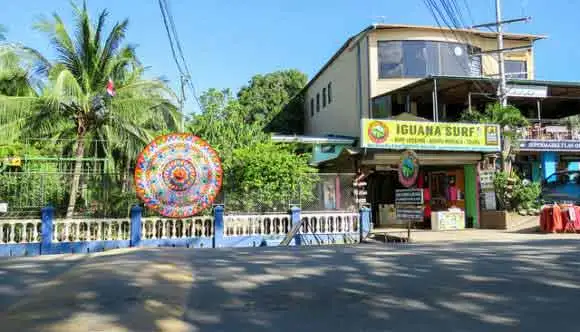
While many expats will find a lower cost of living in Tamarindo than in many coastal North American towns, it’s important to have realistic expectations and know that with an influx of both North American and European expats in recent years, the cost of living has risen here. While the town is full of Central American charm, you will still have access to plenty of modern amenities including high-speed internet, upscale restaurants, and luxury condos.
A monthly budget in Tamarindo will be highly variable depending on the sort of lifestyle you lead. It’s possible to keep things simple and live frugally, but if you plan to have a car and maintain a lifestyle that includes luxuries like frequent meals out and imported goods, a monthly budget could easily climb to between $2,000 and $3,000.
As with most places in the world, the closer you want to live to the beach and to town, the more you’re likely to pay for housing. These locations, however, are often highly sought after, because in general many people enjoy the ability to live in Tamarindo without a car. Going further out of town for more affordable housing often means having to buy some type of vehicle.
Here is a sample monthly budget for a couple in Tamarindo. Included is the cost of a vehicle, although most expats find they don’t need one.
Real Estate in Tamarindo
The beach in Tamarindo is consessioned land. Meaning the government owns the land 150 meters from high tide. Many of the beaches in Costa Rica are consessioned and all beaches are public (if you can get to them). If you “buy” on the beach in Tamarindo, you are leasing the land from the government. Therefore, you do not see many homes (just a few original tico-style homes) on the beach. There are no condo complexes directly on the beach either. However, in suburban Langosta, just to the south, there are expensive homes directly on the beach. What you will see all along the shoreline is a variety of boutique hotels, restaurants, bars, and tourist huts touting fishing trips, horseback rides and (of course) surfing lessons.
The condos and homes in town are walkable to the beach, and some have ocean views. But if you have dreams of walking out your back door and having your toes in the sand – know you are going to have to walk a little further.
There is a great variety of housing from luxury penthouse condos priced at $1 million to basic two-bedroom townhouses for as little as $139,000 and everything in-between. Most of the larger condo complexes have security, although the stand-alone homes do not.
There are several high-end gated communities and independent homes in the hills with sweeping views of Tamarindo Bay. Most of these homes sell for $700,000 and up, those breathtaking Pacific sunsets are hard to beat.
If you go to the outskirts of town or even to the next inland town of Villareal, just 4 kms away, you will find significantly cheaper housing with brand new three-bedroom North American style homes with a pool starting at $225,000 in a gated community. Mid-range properties in established neighborhoods can be found for $100,000 and up.
Below is a sample monthly budget for a couple in Tamarindo. Included is the cost of a vehicle, although many expats find they don’t need one. Keep in mind, health insurance can vary greatly depending of what type of private policy you chose or if you use the public healthcare system (Caja).
| Expense | U.S. $ |
|---|---|
| Housing (rental of a luxury two-bedroom, furnished apartment) | $1,200 |
| Utilities (including water/electricity, internet, and bi-weekly maid service) | $400 |
| Cell Phone (minutes and data for two people) | $40 |
| Maid (twice a month) | 50 |
| Health insurance | 300 |
| Groceries (including some imported goods and alcohol, also based on buying all produce and fish from local market) | $400 |
| Maintenance and fuel for one car | $100 |
| Misc. (personal items, etc.) | $100 |
| Dining Out and Entertainment | $300 |
| Monthly total: | $2,890 |
| Yearly total: | $34,680 |
5 Reasons to Move to Tamarindo, Guanacaste

Considered one of the most developed beach communities in Costa Rica, the once-sleepy fishing and surfer town of Tamarindo has exploded in popularity since the early 2000s. If you ask 100 people who reside there a reason why this is a great place to live, you will most likely hear 100 different reasons. Here are five of the most cited…
1. The Beach
It is hard to deny the beauty of Playa Tamarindo and the surrounding bay. This 1.5-mile beach is positioned in an arching shape flanked by Langosta Beach to the south and Playa Grande to the north. The sand is a honey-colored tan with some striations of black lava sand creating pretty patterns; especially at low tide. Since the sandy and lava rock bottom is long and flat, there is a sizable variance between high and low tide. The bay does not have a permanent harbor, so you will see moored fishing boats, sailboats, and catamarans bobbing in the waves.
The beach is, without a doubt, the heartbeat of Tamarindo. During the day you will find beach walkers, dogs playing in the waves, kids building sandcastles, paddleboarders, and surfers waiting for the perfect break. Evenings, just before sunset, bring out the entire community— locals, expats, tourists—all to witness the breathtaking Pacific sunsets. The perimeter of the beach boasts dozens of festive beach restaurants, bars, and hotels featuring happy hour specials, live music, and fire shows. Even if you are not on vacation, it feels as if you are living one every day.
2. International Atmosphere
It is not unusual to hear five different languages in one day while circulating around Tamarindo. Due to Costa Rica’s close proximity to North America and easy flight routes to get there, it is not a surprise to find most expats hail from Canada and the United States. However, there are communities of British, French, German, Italians, and a smattering of other EU countries as well as many expats from South America, especially Argentina and Chile. So, even if you wanted to live in a gated enclave of expats, you will find it to be multi-national.
One of the best ways to sample new cultures is through their food. Many of the expats who have settled in Tamarindo own restaurants featuring their native cuisine. It is pretty amazing to be able to pick up a croissant at the French bakery for breakfast, enjoy a Tico arroz con pollo for lunch at a soda (traditional family-owned Costa Rican restaurant), and then feast on an authentic plate of Sicilian seafood pasta for dinner - ending with a homemade limoncello digestif.
3. The Weather
What can be a weather negative for some can be a huge positive for others. A larger percentage of expats prefer to settle in the Central Valley around San Jose because the weather at the higher elevations if fairly moderate. However, for some, “moderately” 64 F and rainy feels a little too bone-chilling. In Tamarindo, you will never be cold. The daytime highs can range from the upper 80s F to the mid-90s F and cool off at night into the upper 70s F.
Also, of note, the Guanacaste province is the driest in the country, including Tamarindo. The rainy season officially runs from May through November. However, most months only see a passing afternoon rain shower every few days. Certain weeks in September and October have more consistent rain, but even then, it is rare not to enjoy some sunshine too. So, if wet roads, carrying umbrellas for months, and flip flops splattering mud all over your backside are all a turnoff, Tamarindo is a good place to avoid that for most of the year.
4. Close Proximity to Necessities
Tamarindo is a community with most of all the day-to-day amenities that you need within walking distance. Grocery stores, banks, shops, restaurants, clinics, pharmacies, etc. The town is small enough to walk from one end to the other in about 20 minutes, so many people who live here choose not even own a car. Or have the affordable option of different wheels such as bicycles, scooters, or golf carts.
If there is a need to get out of town, there are taxis, buses or a number of rental car companies in town for longer journeys. For less than a dollar, you can jump in a shared collectivo and ride to the Caja clinic (the closest nationalized medical clinic) or the post office in nearby Villareal. These are unlicensed vehicles many locals utilize to get around.
Tamarindo is also located slightly over an hour’s drive to Liberia’s international airport on completely paved roads, which makes traveling home from a flight fairly efficient. Liberia now has a growing number of big box stores, hardware, car dealers, and home furnishing stores which did not even exist just five years ago. Plus, Liberia has a public and private hospital for major medical, as well as official offices for your residency process, such as migration, fingerprinting, and a driver’s license office. These were all things that used to require a drive to the capital, San Jose, four hours away. Now making life in the Guanacaste area much simpler.
5. Endless Social Options
If you are a social being and you enjoy activities, Tamarindo has an incredibly large choice of things to do in your “retirement”. If you want to learn a new hobby there are classes for painting, learning Spanish, salsa dancing, surfing, SUP paddleboarding, horseback riding, yoga, spin class, etc.
Already accomplished and want to join a poker group, a pickleball team, book club, water aerobics? Check and check. Want to give back to the community? You can help the area vets with strays, you can volunteer for beach clean-ups, you can help local families in need with a skill you possess, or teach English as a second language.
All of this, and more, is available to do in Tamarindo. Everyone will tell you it is easy to forge friendships and fit in. In fact, your social calendar may become busier than before you moved.
Get Your Free Costa Rica Report Here
Get Your Free Costa Rica Report Here
Learn more about Costa Rica and other countries in our daily postcard e-letter. Simply enter your email address below and we’ll send you a FREE REPORT - Explore the Old World in Laidback Costa Rica.

By submitting your email address, you will receive a free subscription to IL Postcards and special offers from International Living and our affiliates. You can unsubscribe at any time, and we encourage you to read more about our Privacy Policy.
5 Unique Day Trips from Tamarindo: Waterfalls, Caves, Turtles, and More!
One of the quintessential ingredients of living or visiting anywhere in Costa Rica is that you are typically within an hour or two drive of some mysterious landmark, amazing national park, or unusual encounter with nature that will knock your socks off. Of course, you most likely won’t be wearing socks, since you’re in a tropical paradise. Tamarindo makes a perfect “home base” beach town for exploring the nearby splendors of the Nicoya Peninsula in northwestern Costa Rica. There are literally hundreds, if not thousands, of things to see and do—some commercial, some natural, but all spellbinding! It is challenging to limit the list to just five.
Llanos de Cortés Waterfall
This waterfall is one of the most spectacular in the area. From Tamarindo make the one-and-a-half-hour drive to Liberia and head south on the Inter-American Highway 1. The turn-off to the falls is in a small town called Bagaces, about 25 miles south, and is easy to miss if you don’t have it routed on Waze or Google Maps. The upgraded park provides a proper parking lot, changing/toilet facilities, lifeguards, and an improved partially concrete stairway.
From the moment you commence the 10- to 15-minute hike, you will hear the roaring power of the waterfall. At the bottom a spectacular 40-foot-high, 49-foot-wide waterfall peeks out from behind the trees. The falls crash into a temperate, natural pool with a sloping sandy beach making it family-friendly and easy for swimming. Plan to pack a picnic lunch and spend the afternoon.
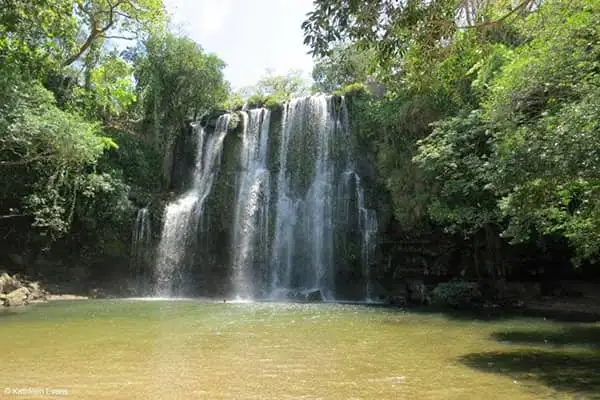
Some guides will take you on a hike through the nearby surrounding jungle. After a 10-minute walk through a muddy, uneven, tree-rooted path, you will be enchanted by a deep, blue swimming hole. Discovering it is almost other-worldly in that it feels like someplace you would imagine “untouched” Costa Rica to look like.
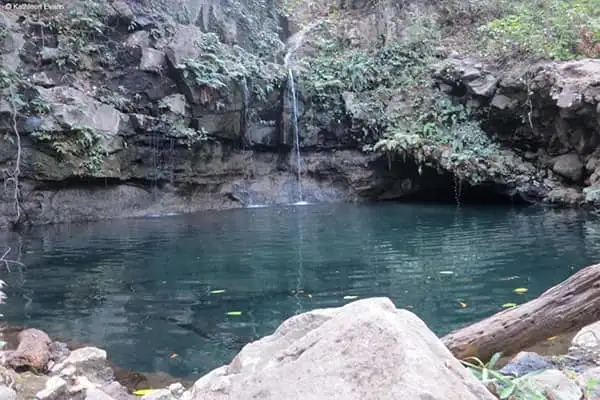
Arribada in Ostional
Sea turtle nesting tours are fairly common in the coastal areas of the country. Annually, during the season, female sea turtles swim hundreds, if not thousands, of miles returning to the very beach where they were hatched to lay their own eggs.
Just under two hours south of Tamarindo, the Olive Ridley Turtles return to a protected beach called Ostional near Nosara. At certain times of the year the extraordinary event of the arribada (or arrival) occurs. It is synchronized typically between July and November under the cloak of darkness anytime between 8 p.m. and 4 a.m.
Certain nights there are only a few swimmers into shore, but during the arribada, the beach becomes a magical parade of hundreds of sea turtles lumbering onto this empty three-mile beach. Most are over two feet long, weighing in at nearly 100 pounds!
Guides are required for safety—ours, the turtles, and the eggs. You can self-drive (beware of dangerous swollen river crossings during rainy season) or take the bus and hire a guide at the Wildlife Refuge or you can book a tour including transportation, entrance fees, and a guide.
These magnificent turtles slowly dig a deep hole in the sand with their enormous flippers for hours and lay approximately 100 soft, ping-pong ball-sized eggs; which you can watch from behind with your guide’s infrared light. The survival rate is extremely slim, and typically only one in five of those eggs actually materialize into a baby turtle who has avoided every peril to make it to the sea. When the female turtles make their way back to the waves, they are so weary they don’t mind humans walking near them. This is the point when you can roam around the arribada in the early morning light and capture astounding photos.
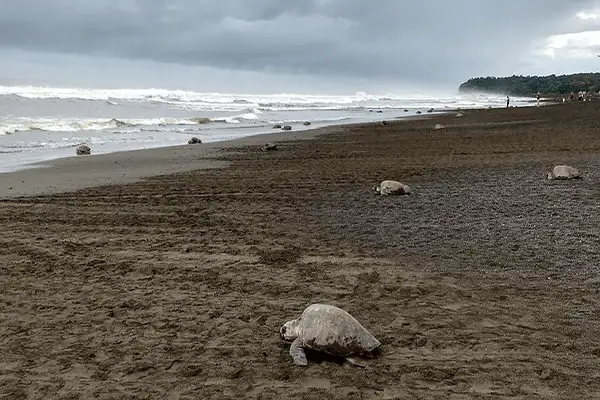
Barra Honda National Park
Located southeast of Tamarindo near the town of Nicoya, the easy one-and-a-half-hour drive leads you to Barra Honda National Park and offers something else to add to Guanacaste province’s unique landscape: Caves!
Barra Honda boasts 40+ caves in a subterranean network around the park. The guided tour (reservations recommended) takes you to Terciepelo Cave. One must be in decent physical health and over the age of 10 years old to descend into the cave system. The entire tour takes three to four hours. There is a one-and-a-half-hour uphill hike and a nearly 200 ft. climb down a ladder to reach this magnificent cave.
The caves will wow you with other-earthly ancient formations of stalagmites and stalactites. The second cave on the tour descends further through a small opening and is not recommended for the claustrophobic.
Palo Verde National Park
Located just over two hours east from Tamarindo, Palo Verde National Park captivates any naturalist with its unique combination of tropical dry forest juxtaposed against its spectacular wetlands. This being a result of the Río Tempisque flooding and creating marshlands over the dry Guanacaste land in this arid climate region.
It is recommended to take the two-hour boat safari through the wetlands. Birds are the number one attraction (although don’t be surprised to see some crocs, iguanas, monkeys, bats, and other wildlife). Birders and wildlife photographers from around the world marvel at catching the perfect click.
Diamante Eco Adventure Park
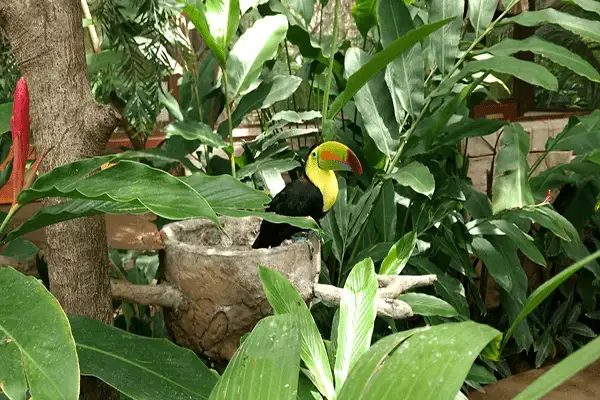
Although a bit more commercial than the natural places on the list, Diamante Eco-Adventure Park is the perfect all-in-one location in Guanacaste to fulfill the Costa Rica “bucket list” items. Located close to Playas del Coco at Matapalo Beach about one-and-a-half hour’s drive north from Tamarindo.
Their custom-built zipline boasts the longest side-by-side zip in Central America (approximately one mile). As they harness you into the “Superman” position next to your partner and send you sailing at 60mph towards the ocean, you’ll feel an adrenaline rush like no other.
A stroll through the animal sanctuary offers a chance to get up close to the MINEA (Ministry of Wildlife) rescued animals in a natural-looking habitat. Home to such Costa Rican treasures like iconic “Lucy” the sloth, the native jaguars, and friendly toucans who pose for endless photos. The blue morpho butterfly observatory is also magical. The unique blue hue they possess is mesmerizing while hundreds encompass you.
Diamante has over 200 acres of park to play on ATVs roaring on the mountainous trails or horseback riding. And after all that excitement you can lazily relax at the beach on a hammock. Top it off with a traditional tico buffet lunch and you have a perfect day of Costa Rica 101.
10 Things to Do in Tamarindo
By Kathleen Evans
Ride a Wave
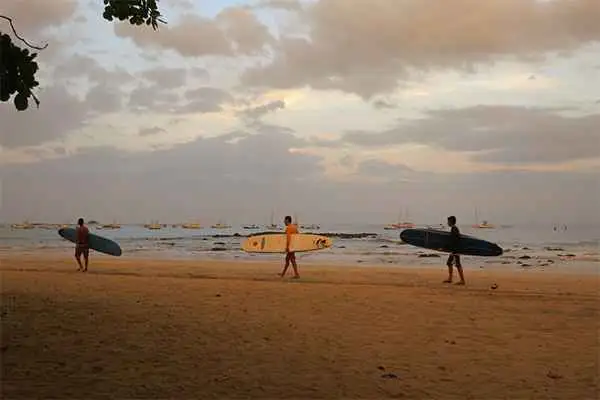
The classic 1994 surfing movie Endless Summer II put Tamarindo on the map for surfers around the world. So, it is no surprise that you can find a surf shop on nearly every corner offering equipment for rent or for sale and top-notch instructors for all skill levels. The breaks are excellent for beginners and intermediates. You may even catch a glimpse of Robert August around town, Tamarindo’s local celebrity world-class surfer from Endless Summer, the original 1966 version.
Habla Español
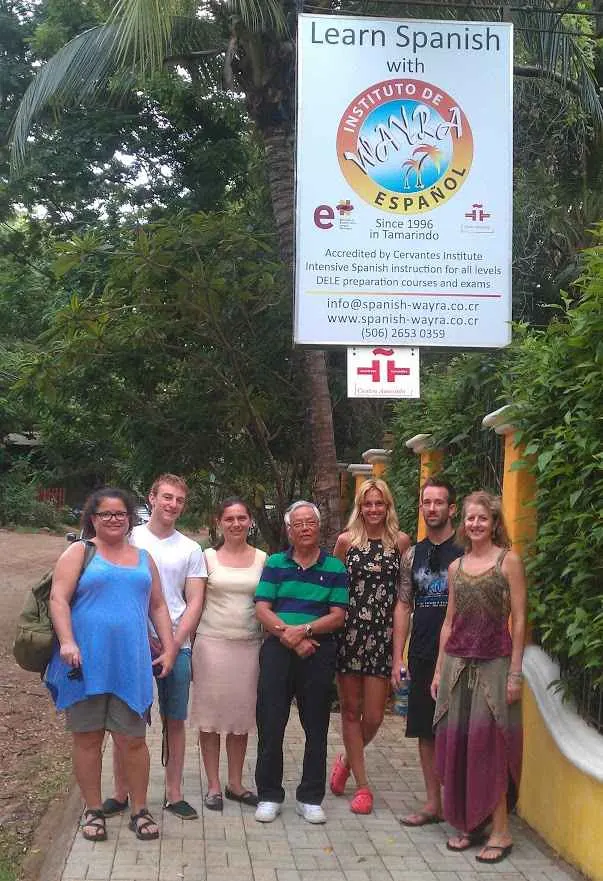
Immersion is a great way to learn Spanish as a second or third language. Tamarindo boasts three accredited schools that also offer lodging and host family opportunities. From one week to three months, you can attend to your desired level. And if traditional classrooms are not your thing, there are a number of locals who teach informal classes for expats. Or you can hire a tutor and customize a program for you. It will help you assimilate into the culture at a much faster rate and the ticos truly appreciate your efforts to be part of the community.
Dine Around the World
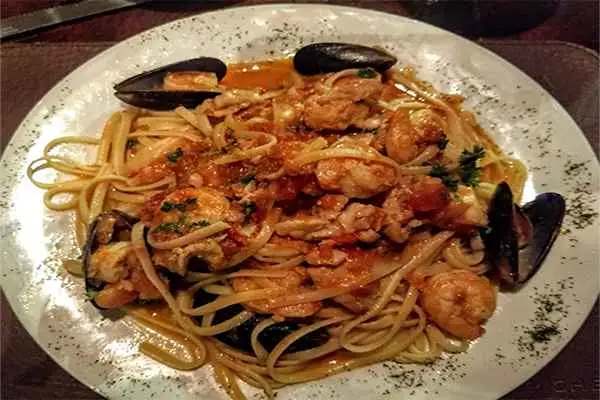
Foodies rejoice! Costa Rican food, albeit healthy, has a long history of being rather uninspiring. Not anymore. With the influx of international foreigners to Tamarindo, many area chefs are fusing the flavors of their home country to create unique and savory dishes you can’t find anywhere else. Some restaurants are high-end and others casual, but all worth a stop on your gastronomic tour. French, Chinese, Italian, Israeli, Korean, Japanese, Argentinian, Peruvian, Indian, Venezuelan, and Thai dishes abound.
Paddle Your Way to a Pickleball (or Tennis) Tournament

Paddleball in the expat communities has become the rage around the world, including Costa Rica. For those unfamiliar with this addictingly fun sport, it combines elements of tennis, badminton, and ping-pong. It is played on a badminton-sized court with a slightly modified tennis net. Players use a paddle and a plastic ball with holes and it is played as doubles or singles. The Tamarindo Pickleball and Tennis Club offers everything from beginner clinics to camps and weekly tournaments for both adults and kids. And if tennis is your preferred sport on the court, it is alive and well in Tamarindo too!
Come Fly with Us

For an alternative to the typical heart-pounding ziplining activity found around the country, you can soar above the area beaches and jungles in an open-air ultralight helicopter. Just you, the licensed pilot, and the wild blue yonder. The tours vary from 20-minutes to a full hour with the ultralight flying low enough to spot wildlife but high enough to capture your imagination. The tours leave from nearby Tamarindo airport just outside of town.
Catch the Big One

Anglers know that Costa Rica’s Pacific coast is teeming with sea life throughout the year; making any month a good time for fishing. There are several sport fishing companies and local fishermen offering half and full-day expeditions. You can rent a comfortable yacht for the entire group or just venture out with a local on his panga (a small outboard motorboat) and enjoy a day on the high seas. The Pacific Coast is famous for offshore Sailfish, Marlin, Dorado, Wahoo, and Yellowfin Tuna. Inshore, Roosterfish, Snook, and Snapper are frequently reeled in. Your crew will filet your catch and put it on ice for you to take home and cook—or better yet, bring to one of Tamarindo’s fabulous restaurants for them to tantalize your tastebuds!
Shop Till You Drop at the Thursday Moonlight Market & Saturday Feria

Unlike most weekly open-air ferias (farmer’s markets) around Costa Rica, selling fresh farm-to-market produce, meats, seafood, and other sundries, the Tamarindo Thursday Moonlight market is more of a fiesta. Located “up the hill” (ask any local), you will hear local bands and smell incredible street food wafting through the air as you approach. Here you find vendors selling delicious snacks from open grills, local arts (think jewelry and tie-dye), craft cocktails, and even “happy brownies” (again, ask a local). The Saturday morning feria in Oneida Skate Park is a bit more traditional in that you will find local produce and seafood, but also crafts, spices, flowers, and other surprises.
Take an Estuary Tour
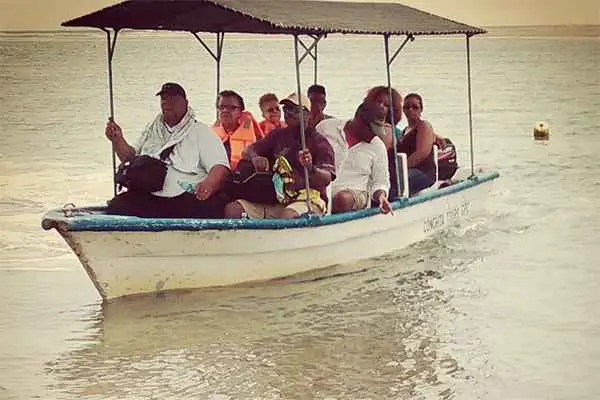
On the north end of Tamarindo sits an estuary that divides Tamarindo beach from Playa Grande. Rio Matapalo winds through Las Baulas National Park (a protected park for the Leatherback sea turtles nesting areas). These brackish waters exhibit a legion of flora and fauna to satisfy any naturalist. You will likely see crocodiles in the mangroves, green parrots gliding by, and howler monkeys in the treetops within this small, but diverse dry forest ecosystem. The tours are two hours via panga beginning in the park where the estuary meets the ocean heading out of Tamarindo on the main road.
Indulge in a Perfect Sundowner

Although Costa Rica has approximately 631 miles of Pacific coastline, anyone who has witnessed a sunset on Tamarindo beach will tell you it is a bewitching event. It seems the entire community comes together each day as the sun sinks into the sea. Joggers, surfers, dog-walkers, yogis, dancers, revelers, families—tourists, expats, and locals alike—all come together on this one-and-a-half-mile arcing piece of sand. Music and laugher whirl from the many beach bars, while the mariachis stroll by in their colorful costumes. Phones capture the day’s finale and glasses are raised to cheer another sunset in paradise. Salud!
Find Inner Peace Within the World’s Largest Labyrinth

Although not technically in Tamarindo proper, La Senda is a short 15-minute drive away in nearby Santa Rosa. La Senda (the path) has fast become a wellness center away from the madness of humanity—offering a quiet sanctuary for finding your inner spirit. Taking over six years to develop, they now host retreats, concerts, and organic dinners/cooking classes. But the shining star of La Senda is the labyrinth—not to be confused with a maze—created around two strong energy fields (male/female). It is the biggest in the world measuring over tw0-and-a-half acres. The path is almost two miles long and circles around these energy fields routing you between 5,000 cacti.
Get Your Free Costa Rica Report Here
Get Your Free Costa Rica Report Here
Learn more about Costa Rica and other countries in our daily postcard e-letter. Simply enter your email address below and we’ll send you a FREE REPORT - Explore the Old World in Laidback Costa Rica.

By submitting your email address, you will receive a free subscription to IL Postcards and special offers from International Living and our affiliates. You can unsubscribe at any time, and we encourage you to read more about our Privacy Policy.
